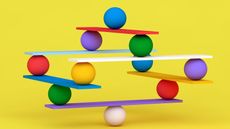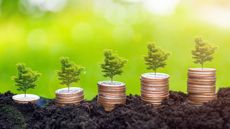Get More Yield with Blue-Chip Stocks
Take advantage now while the Great Dividend Shift is offering stocks yielding more than bonds.

One of the best measures of how the market is valuing a stock is the dividend yield -- a stock's annual payout divided by its share price. A dividend yield that's high compared with the interest rate on bonds is often a sign of a real bargain. Right now, the dividend yield of the average stock is, in fact, very high compared with the interest rate on bonds.
At the very least, today's yields indicate that stocks offer better value than bonds. Investors are missing a good deal if they ignore this signal, and the best way to exploit the situation is by purchasing solid companies that pay consistent dividends.
Consider Colgate-Palmolive (symbol CL). The consumer-products giant -- a maker of toothpaste, deodorant and detergent -- has paid dividends without interruption since 1895 and has increased its payout annually for the past 47 years. At a share price of $74, the stock yields 2.8%. If you think that's low, think again. Ten-year Treasury bonds yield 2.4%, and the yield on five-year Treasury notes is only 1.1% (all data is through October 8).

Sign up for Kiplinger’s Free E-Newsletters
Profit and prosper with the best of expert advice on investing, taxes, retirement, personal finance and more - straight to your e-mail.
Profit and prosper with the best of expert advice - straight to your e-mail.
Topsy-turvy yields
When a blue-chip stock yields more than a Treasury bond, that is a tremendous opportunity for investors. In fact, the average stock in the Dow Jones industrial average now yields 0.2 percentage point more than ten-year U.S. government debt and 1.5 points more than five-year notes.
Even more remarkable, the broader Standard & Poor's 500-stock index, a good proxy for the market as a whole, began outyielding five-year notes in 2009. And the S&P 500's yield is now approaching that of the ten-year bond for the first time in more than half a century.
What's going on? On the one hand, investors, worried about the lackluster U.S. economy, global debt troubles, falling currencies and other potential crises, have been looking for a safe haven. So they have been loading up on bonds, bidding up their prices and driving down their yields (bond yields move in the opposite direction of prices). Because inflation is virtually nonexistent, bonds are palatable despite low interest rates. On the other hand, many companies have cut costs and are generating solid profits even though sales have been growing modestly. Companies are building up cash, which they are returning to shareholders in the form of higher dividends, in part to make their stocks more attractive.
Colgate is a good example. Although its sales in 2009 were flat compared with the year before, net income jumped 17%, and the company ended the year with nearly twice as much cash as it had in 2005. A big reason is that while the U.S. economy is sluggish, much of the rest of the world -- especially developing nations -- is doing well, and three-fourths of Colgate's sales are abroad.
As a result, we're back in the mid 1950s when it comes to the relationship between bond income and stock income. In 1929, the year the stock market crashed in advance of the Great Depression, medium-maturity bonds and large-capitalization stocks had roughly equal yields of about 4%. But for the next three decades, dividend yields climbed well ahead of bond interest rates. Investors were still shellshocked from the Depression and the accompanying collapse in share prices. To get them to buy stocks, companies had to offer hefty payouts. Even in 1951, when long-term Treasuries were yielding just 2.4%, big-company stocks were paying an average of 6.9%.
Then in 1958, the S&P 500 shot up 38%, and the investing landscape changed. Dividend yields plummeted, and the interest rate on Treasuries rose. For the next 51 years, bond yields beat stock yields. The next reversal wouldn't come until 2009, when the five-year T-note fell from 4.4% to 2.2%, and stock yields rose from 1.9% to 2.5%. This year, the gap has widened further, from three-tenths of a percentage point to nine-tenths of a point (the S&P 500 now yields 2.0%).
Some companies pay no dividends at all, preferring to reinvest the money they earn in new machines or factories, and all companies try to hang on to some cash for working capital. But 74% of the large-cap concerns that make up the S&P 500 distribute some of their profits each quarter to the shareholders who own the company.
Those dividends are the best indicator of corporate health. Managers are highly reluctant to cut payouts, so this year's dividend is a harbinger of likely future earnings. A company that raises its payout year after year must have a significant edge over its competitors -- a great brand, a wall of patents or simply a tradition of strong leadership.S&P maintains a list of "dividend aristocrats" -- companies in the S&P 500 that have raised their dividends for at least 25 consecutive years. The list currently holds 42 names, from insurer Aflac (AFL) to retailer Walgreen (WAG). It's not easy for companies to keep their privileged status. In 2001, there were 64 names on the list; some big ones, including General Electric (GE), Pfizer (PFE) and U.S. Bancorp (USB), fell off the list in 2009. (For more on the aristocrats, see The Best List and Ask Kim.)
Many of the aristocrats now boast delicious yields. For example, McDonald's (MCD, $76) yields 3.2%; Eli Lilly (LLY, $37), 5.3%; and Kimberly-Clark (KMB, $66), 4.0%. And I would not sneer at aristocrats yielding less than 3% -- for instance, Emerson Electric (EMR, $53), at 2.5%; Exxon Mobil (XOM, $64), 2.7%; and Stanley Black & Decker (SWK, $63), 2.2%.
If you buy an exchange-traded fund called SPDR S&P Dividend ETF (SDY), you can own another take on dividend aristocrats. The portfolio consists of the 50 highest-yielding stocks among companies in the S&P Composite 1500 (a larger universe than the S&P 500, including small and mid caps) that have raised dividends for at least 25 years in a row. The fund's current yield is 3.7%, and it charges 0.35% a year for expenses.
Dividend stocks are supposed to provide ballast in rough seas. SPDR Dividend, launched in 2005, showed its mettle in 2008 when its value fell 23%, while the full S&P 500 surrendered 37%. What is more surprising is that SPDR Dividend has returned 13.8% so far in 2010, or eight points better than the S&P 500.
How can supposedly tame dividend stocks be performing so well? The debacle of 2008 and early 2009 drove many investors out of stocks and into bonds. Nearly all stocks got cheap, including those -- like solid dividend-payers -- that didn't deserve wallflower status. Now, it seems, more investors are waking up to the joys of companies like the aristocrats.
As they should. A simple freeze-frame comparison between a stock and a bond only begins to tell the story. For instance, a $10,000 Treasury bond maturing in 2020 currently pays interest of about $240 annually. If you invest $10,000 in the aristocratic Procter & Gamble (PG), which has paid an uninterrupted dividend for more than a century, you collect annual dividend income of $310.
Now, let's assume that P&G increases its dividend by 7% a year. In 2020, it will pay someone who invests $10,000 more than $600 for the year in dividends, while the T-bond continues to pay $240. Of course, with a stock there is no guarantee that a dividend won't be reduced -- or even eliminated entirely. But companies such as P&G have records that suggest such cuts are unlikely.
The point is that even when stocks yield less than bonds at the outset, they often put more cash in your pocket over time. Today, great companies such as P&G and Kimberly-Clark, makers of the sorts of household products whose sales stay steady even in bad times, are yielding more than bonds.
Will the current Great Dividend Shift persist for another half-century, the way the previous one did? I would not count on it. Get 'em now, while they're cold.
James K. Glassman's new book, Safety Net, will be published in February. He does not own any of the stocks mentioned.

-
 What Happens Financially When You Work One More Year?
What Happens Financially When You Work One More Year?The impact of saving more, spending less later and benefiting from an extra year or more of compounding can be truly staggering.
By Andrew Rosen, CFP®, CEP Published
-
 Seven Ways to Spend Your Tax Refund
Seven Ways to Spend Your Tax RefundYou may want to splurge, but using your tax refund to save for the future or pay down debt is a much better idea — even if not as fun.
By Kathryn Pomroy Published
-
 5 Big Tech Stocks That Are Bargains Now
5 Big Tech Stocks That Are Bargains Nowtech stocks Few corners of Wall Street have been spared from this year's selloff, creating a buying opportunity in some of the most sought-after tech stocks.
By James K. Glassman Published
-
 How to Invest for a Recession
How to Invest for a Recessioninvesting During a recession, dividends are especially important because they give you a cushion even if the stock price falls.
By James K. Glassman Published
-
 10 Stocks to Buy When They're Down
10 Stocks to Buy When They're Downstocks When the market drops sharply, it creates an opportunity to buy quality stocks at a bargain.
By James K. Glassman Published
-
 How Many Stocks Should You Have in Your Portfolio?
How Many Stocks Should You Have in Your Portfolio?stocks It’s been a volatile year for equities. One of the best ways for investors to smooth the ride is with a diverse selection of stocks and stock funds. But diversification can have its own perils.
By James K. Glassman Published
-
 An Urgent Need for Cybersecurity Stocks
An Urgent Need for Cybersecurity Stocksstocks Many cybersecurity stocks are still unprofitable, but what they're selling is an absolute necessity going forward.
By James K. Glassman Published
-
 Why Bonds Belong in Your Portfolio
Why Bonds Belong in Your Portfoliobonds Intermediate rates will probably rise another two or three points in the next few years, making bond yields more attractive.
By James K. Glassman Published
-
 140 Companies That Have Pulled Out of Russia
140 Companies That Have Pulled Out of Russiastocks The list of private businesses announcing partial or full halts to operations in Russia is ballooning, increasing economic pressure on the country.
By Brad Moon Published
-
 How to Win With Game Stocks
How to Win With Game Stocksstocks Game stocks are the backbone of the metaverse, the "next big thing" in consumer technology.
By James K. Glassman Published